Abstract
During a two year period prospective continuous electroencephalographic (EEG) monitoring of 275 infants identified seizure activity in 55 cases, 31 of whom were treated with anticonvulsant drugs on clinical grounds. EEG and clinical response was complete in only two and equivocal in another six. Clinical response with persistent EEG seizures occurred in 13 and neither clinical nor EEG response in 10. There was no significant improvement in the generally poor neurological outcome compared with that in 24 infants whose seizures were not treated because of limited or absent clinical manifestations. Background EEG abnormality (as an index of associated cerebral dysfunction) was a guide to potential lack of response to anticonvulsant drugs; it was also predictive of subsequent clinical outcome irrespective of treatment. This study shows that commonly used anticonvulsant drugs (phenobarbitone, paraldehyde, phenytoin, and diazepam) have little effect on seizure control or neurological outcome in neonatal seizures associated with haemorrhagic, hypoxic, or ischaemic cerebral lesions. In view of the variable clinical appearance of EEG seizure activity, continuous EEG monitoring should be an essential feature of further study of neonatal anticonvulsant treatment.
Full text
PDF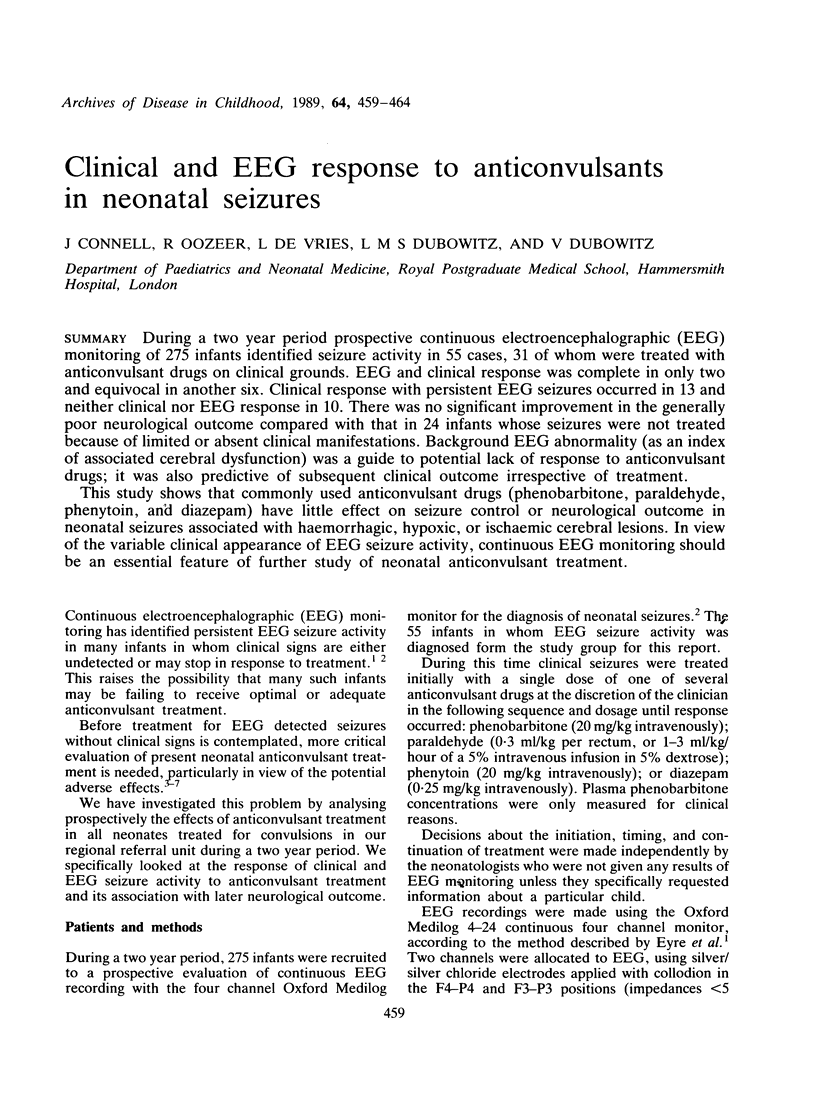
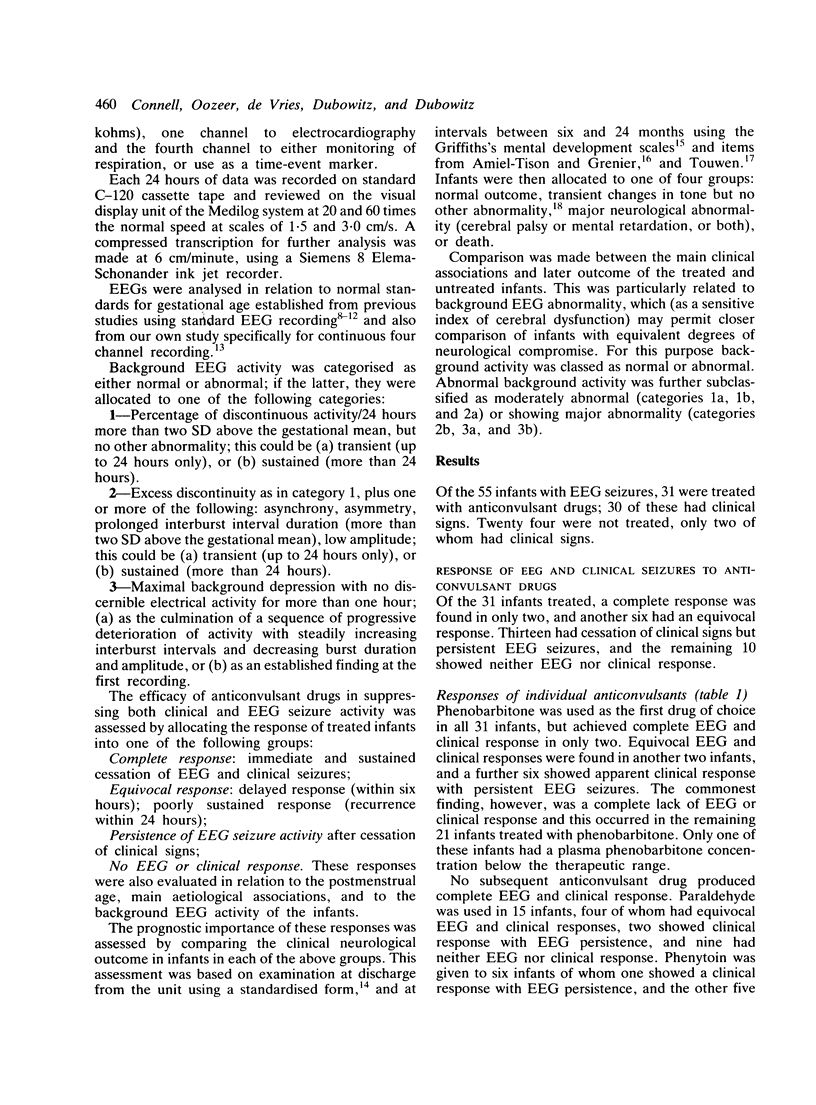
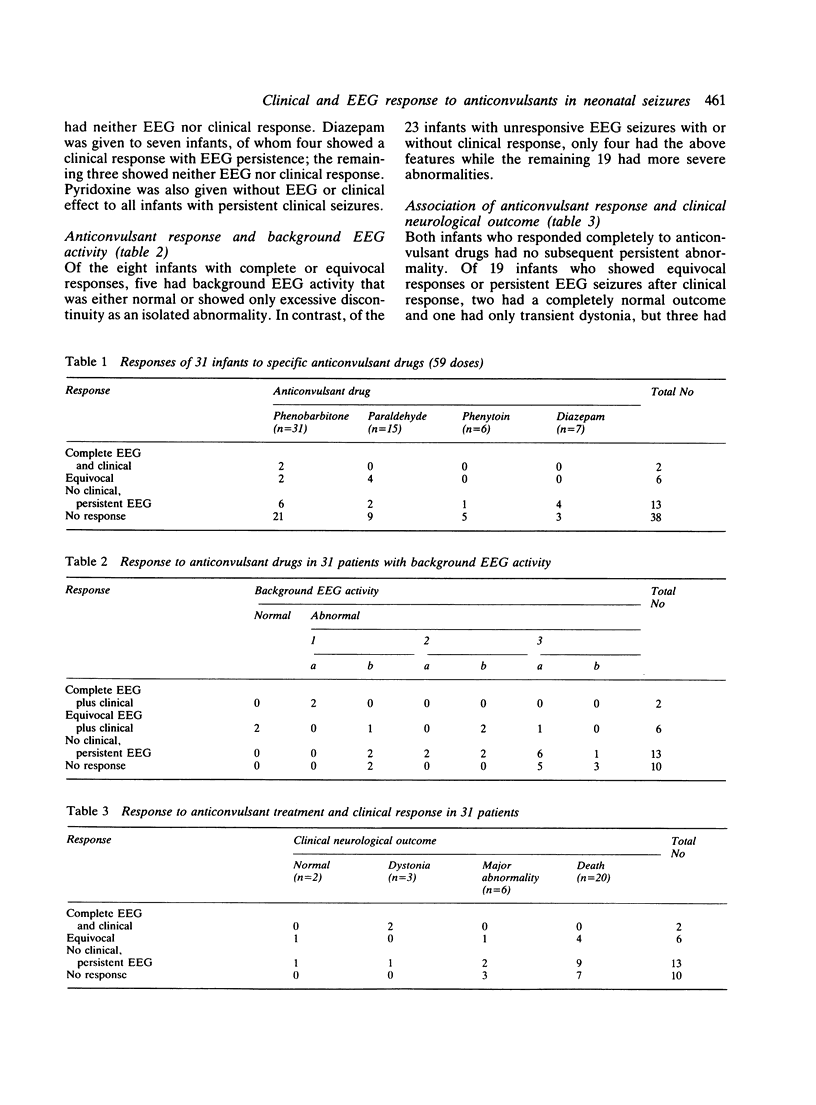
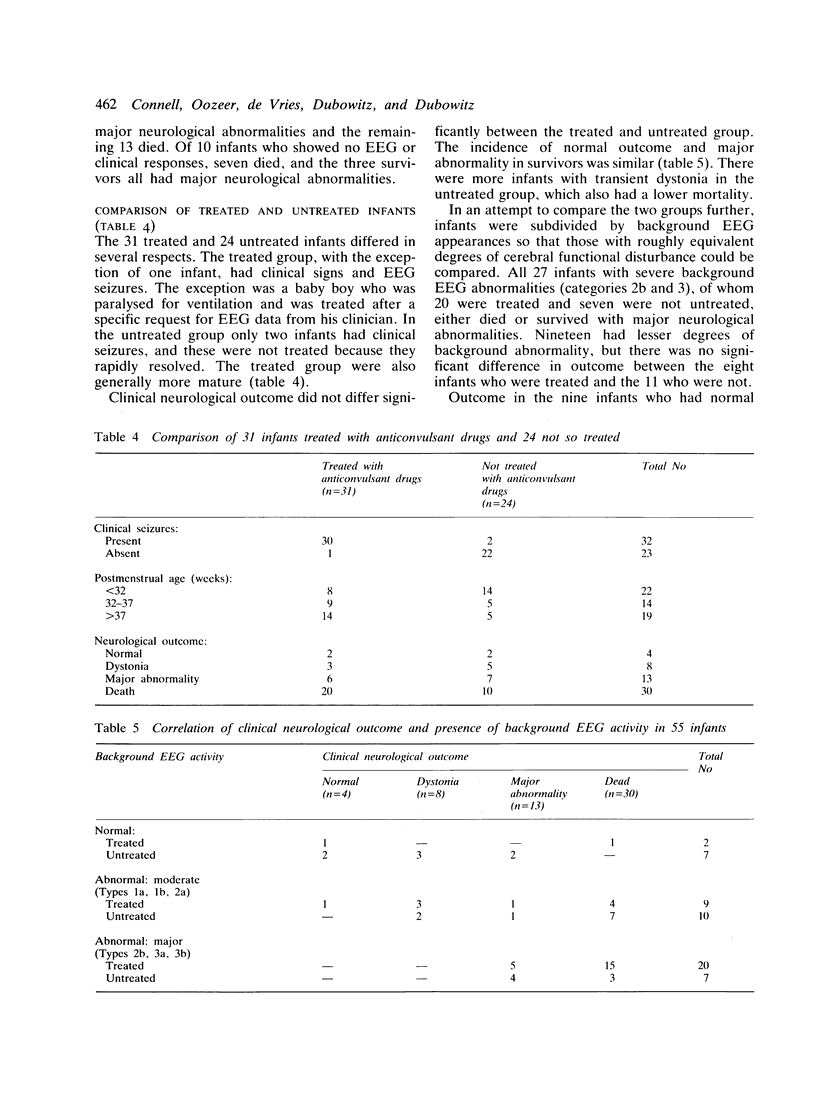

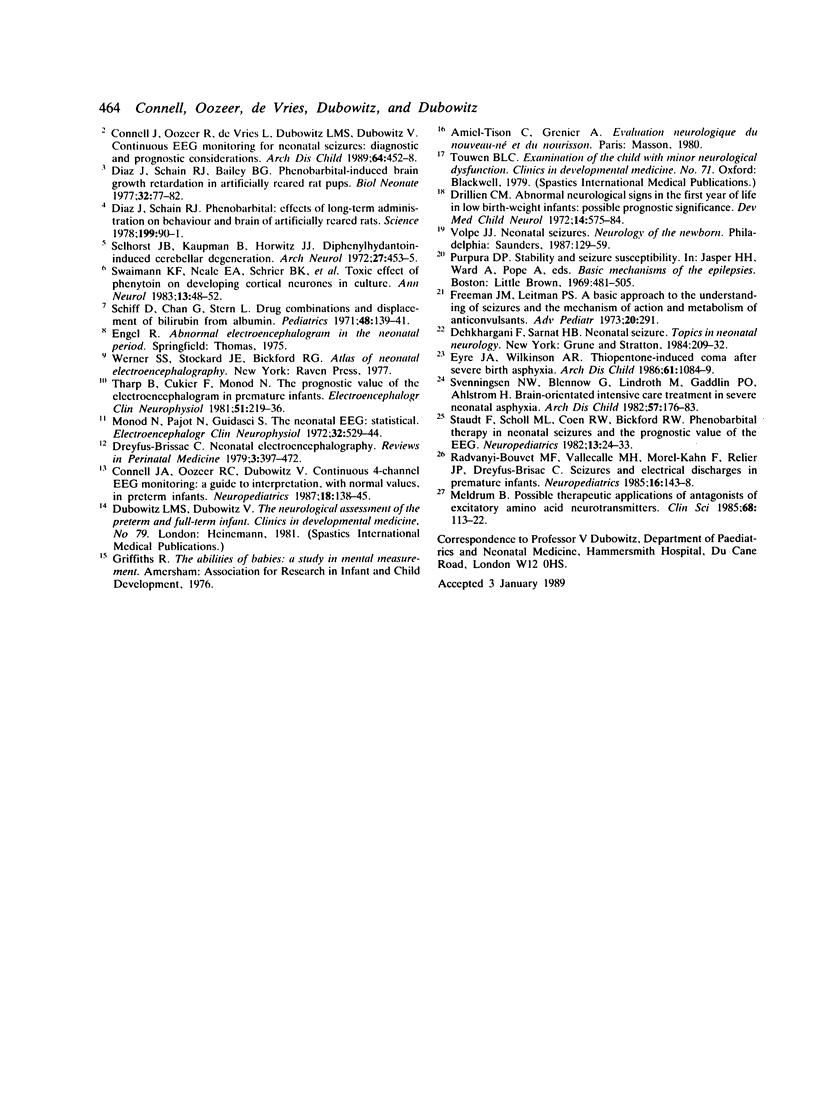
Selected References
These references are in PubMed. This may not be the complete list of references from this article.
- Connell J. A., Oozeer R., Dubowitz V. Continuous 4-channel EEG monitoring: a guide to interpretation, with normal values, in preterm infants. Neuropediatrics. 1987 Aug;18(3):138–145. doi: 10.1055/s-2008-1052466. [DOI] [PubMed] [Google Scholar]
- Connell J., Oozeer R., de Vries L., Dubowitz L. M., Dubowitz V. Continuous EEG monitoring of neonatal seizures: diagnostic and prognostic considerations. Arch Dis Child. 1989 Apr;64(4 Spec No):452–458. doi: 10.1136/adc.64.4_spec_no.452. [DOI] [PMC free article] [PubMed] [Google Scholar]
- Diaz J., Schain R. J., Bailey B. G. Phenobarbital-induced brain growth retardation in artificially reared rat pups. Biol Neonate. 1977;32(1-2):77–82. doi: 10.1159/000240998. [DOI] [PubMed] [Google Scholar]
- Drillien C. M. Abnormal neurologic signs in the first year of life in low-birthweight infants: possible prognostic significance. Dev Med Child Neurol. 1972 Oct;14(5):575–584. doi: 10.1111/j.1469-8749.1972.tb02639.x. [DOI] [PubMed] [Google Scholar]
- Eyre J. A., Oozeer R. C., Wilkinson A. R. Diagnosis of neonatal seizure by continuous recording and rapid analysis of the electroencephalogram. Arch Dis Child. 1983 Oct;58(10):785–790. doi: 10.1136/adc.58.10.785. [DOI] [PMC free article] [PubMed] [Google Scholar]
- Eyre J. A., Wilkinson A. R. Thiopentone induced coma after severe birth asphyxia. Arch Dis Child. 1986 Nov;61(11):1084–1089. doi: 10.1136/adc.61.11.1084. [DOI] [PMC free article] [PubMed] [Google Scholar]
- Freeman J. M., Lietman P. S. A basic approach to the understanding of seizures and the mechanism of action and metabolism of anticonvulsants. Adv Pediatr. 1973;20(0):291–321. [PubMed] [Google Scholar]
- Meldrum B. Possible therapeutic applications of antagonists of excitatory amino acid neurotransmitters. Clin Sci (Lond) 1985 Feb;68(2):113–122. doi: 10.1042/cs0680113. [DOI] [PubMed] [Google Scholar]
- Monod N., Pajot N., Guidasci S. The neonatal EEG: statistical studies and prognostic value in full-term and pre-term babies. Electroencephalogr Clin Neurophysiol. 1972 May;32(5):529–544. doi: 10.1016/0013-4694(72)90063-6. [DOI] [PubMed] [Google Scholar]
- Radvanyi-Bouvet M. F., Vallecalle M. H., Morel-Kahn F., Relier J. P., Dreyfus-Brisac C. Seizures and electrical discharges in premature infants. Neuropediatrics. 1985 Aug;16(3):143–148. doi: 10.1055/s-2008-1052559. [DOI] [PubMed] [Google Scholar]
- Schiff D., Chan G., Stern L. Fixed drug combinations and the displacement of bilirubin from albumin. Pediatrics. 1971 Jul;48(1):139–141. [PubMed] [Google Scholar]
- Selhorst J. B., Kaufman B., Horwitz S. J. Diphenylhydantoin-induced cerebellar degeneration. Arch Neurol. 1972 Nov;27(5):453–455. doi: 10.1001/archneur.1972.00490170085012. [DOI] [PubMed] [Google Scholar]
- Staudt F., Scholl M. L., Coen R. W., Bickford R. B. Phenobarbital therapy in neonatal seizures and the prognostic value of the EEG. Neuropediatrics. 1982 Feb;13(1):24–33. doi: 10.1055/s-2008-1059591. [DOI] [PubMed] [Google Scholar]
- Svenningsen N. W., Blennow G., Lindroth M., Gäddlin P. O., Ahlström H. Brain-orientated intensive care treatment in severe neonatal asphyxia. Effects of phenobarbitone protection. Arch Dis Child. 1982 Mar;57(3):176–183. doi: 10.1136/adc.57.3.176. [DOI] [PMC free article] [PubMed] [Google Scholar]
- Swaiman K. F., Neale E. A., Schrier B. K., Nelson P. G. Toxic effect of phenytoin on developing cortical neurons in culture. Ann Neurol. 1983 Jan;13(1):48–52. doi: 10.1002/ana.410130111. [DOI] [PubMed] [Google Scholar]
- Tharp B. R., Cukier F., Monod N. The prognostic value of the electroencephalogram in premature infants. Electroencephalogr Clin Neurophysiol. 1981 Mar;51(3):219–236. doi: 10.1016/0013-4694(81)90136-x. [DOI] [PubMed] [Google Scholar]


